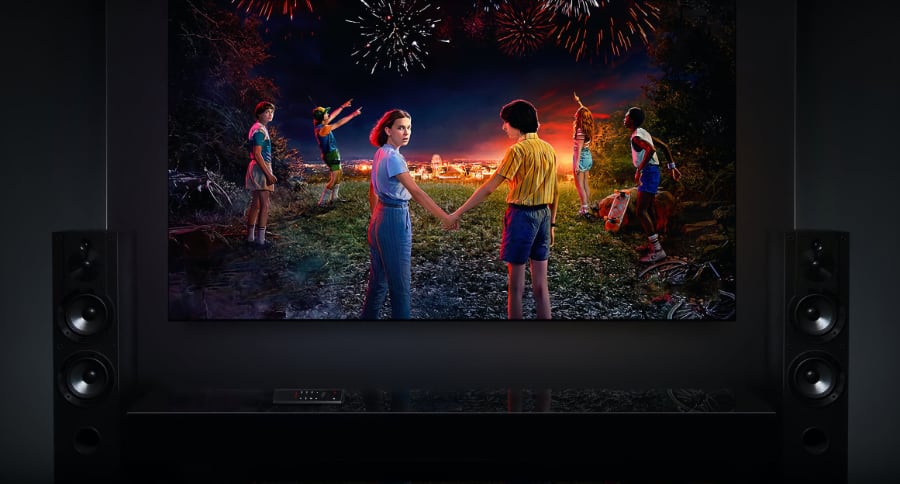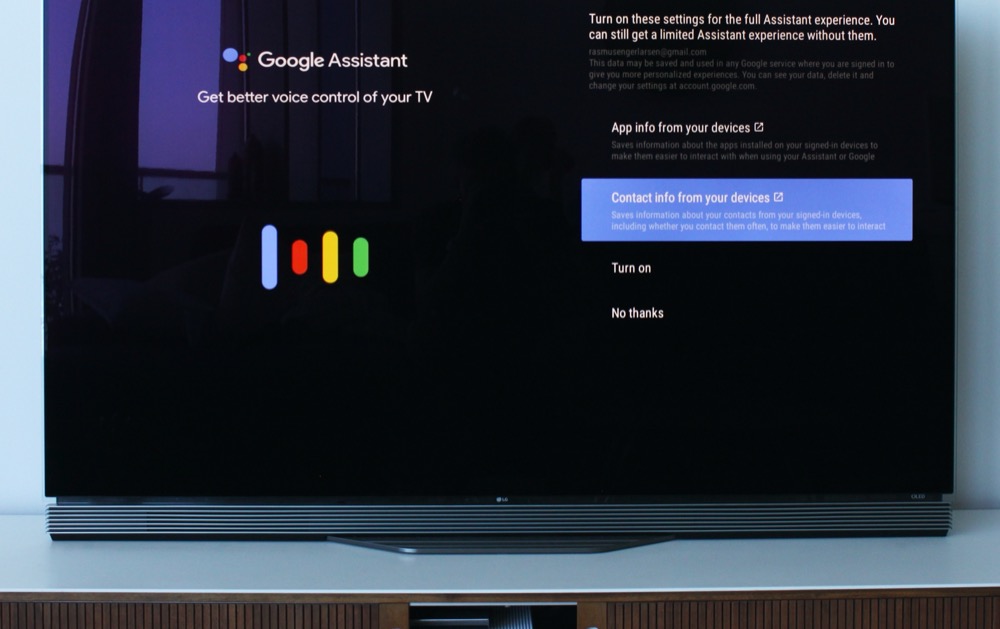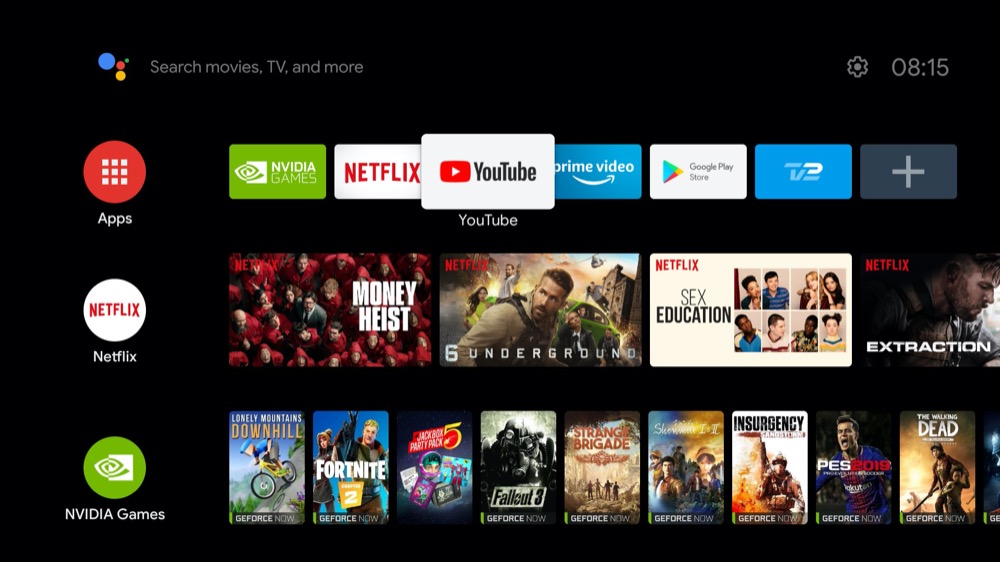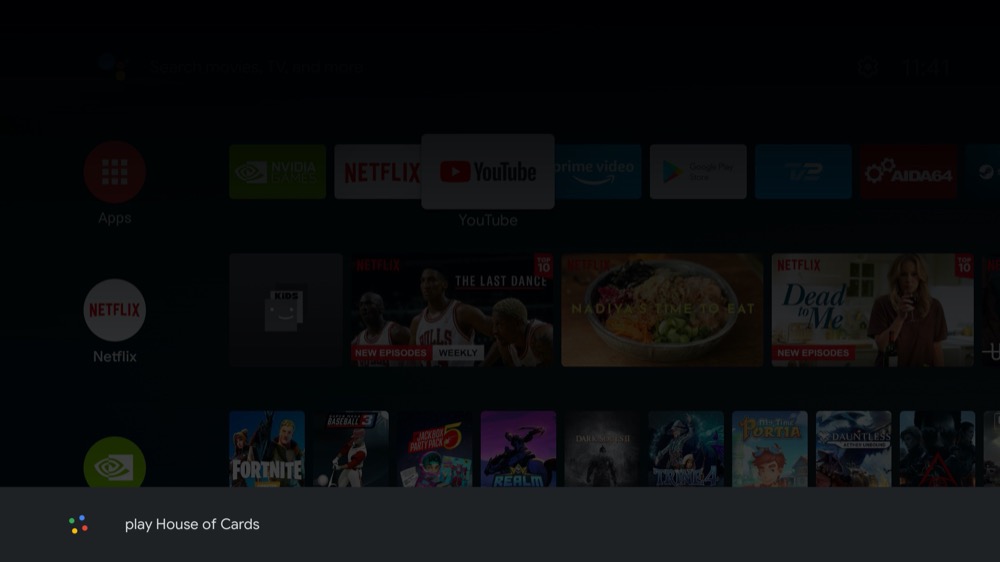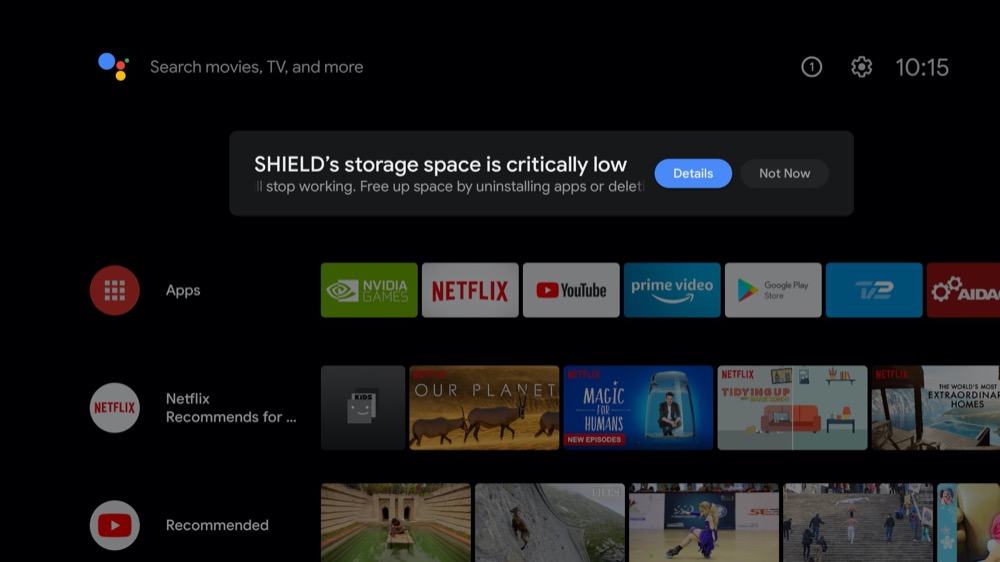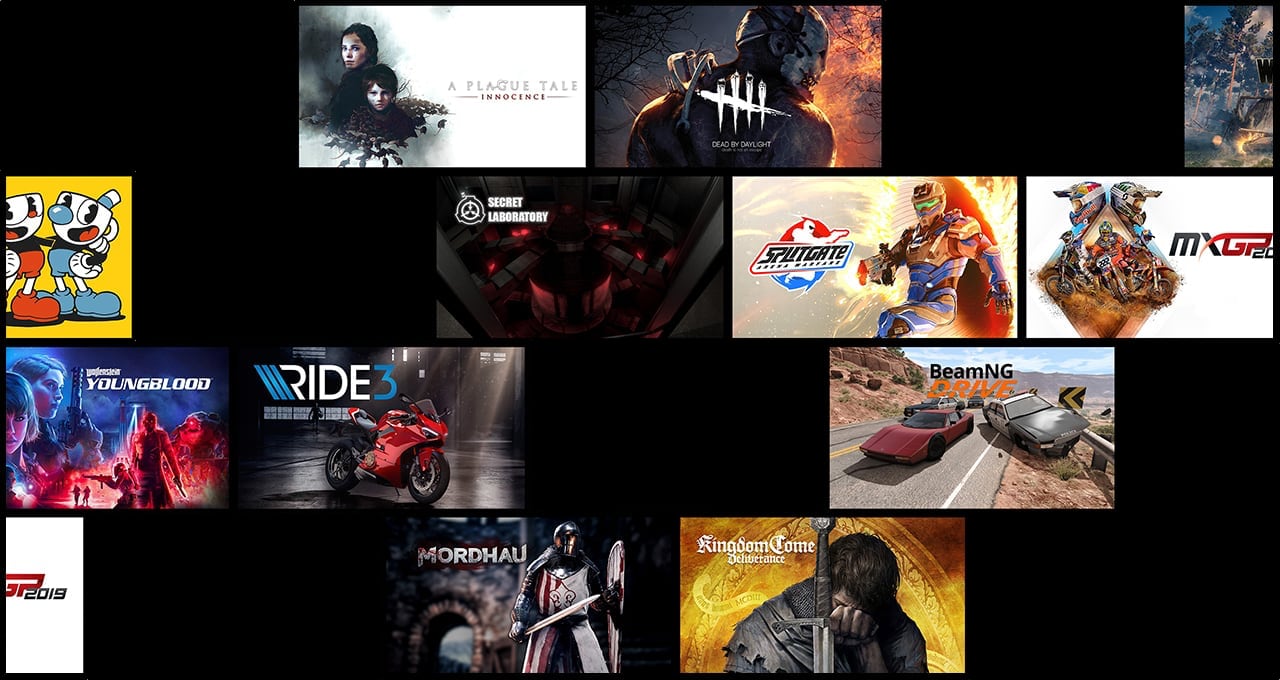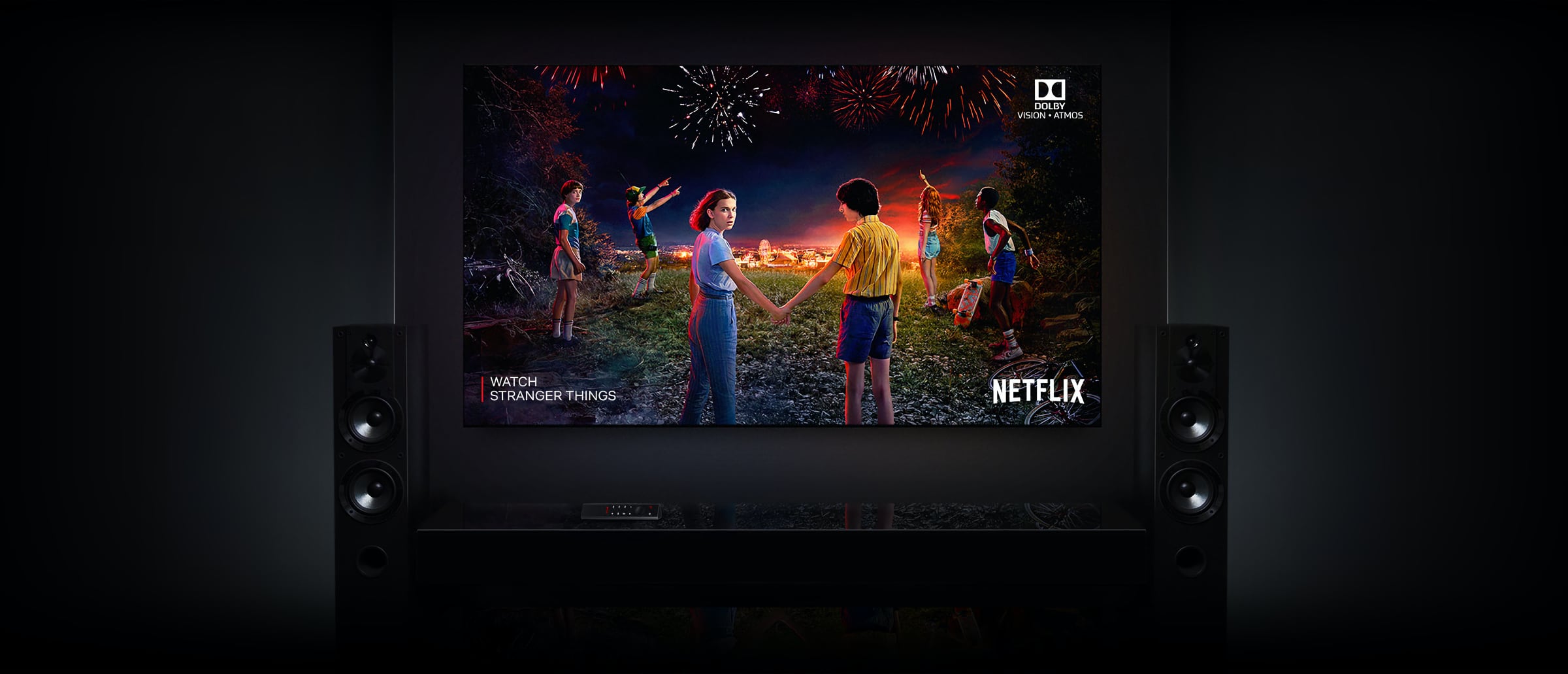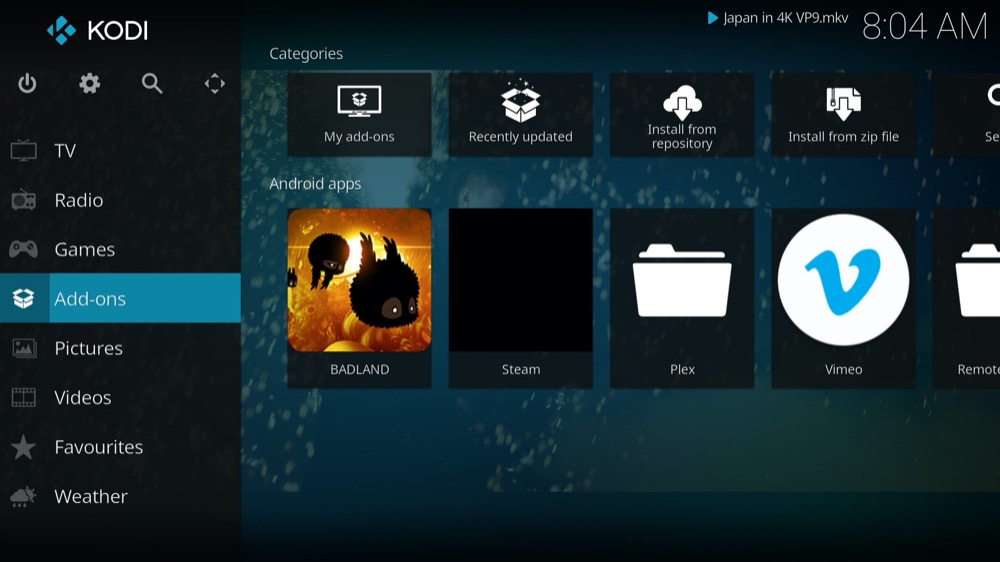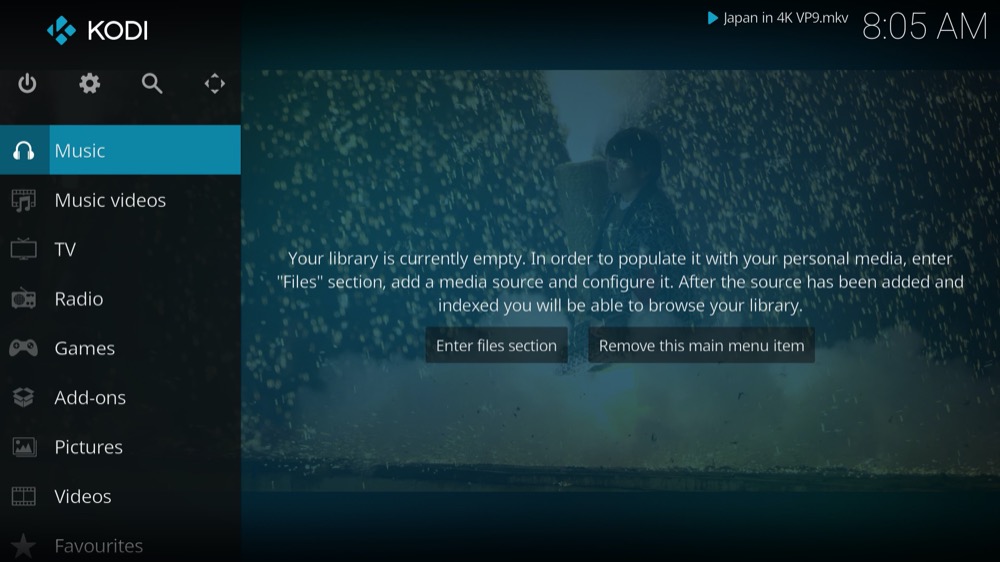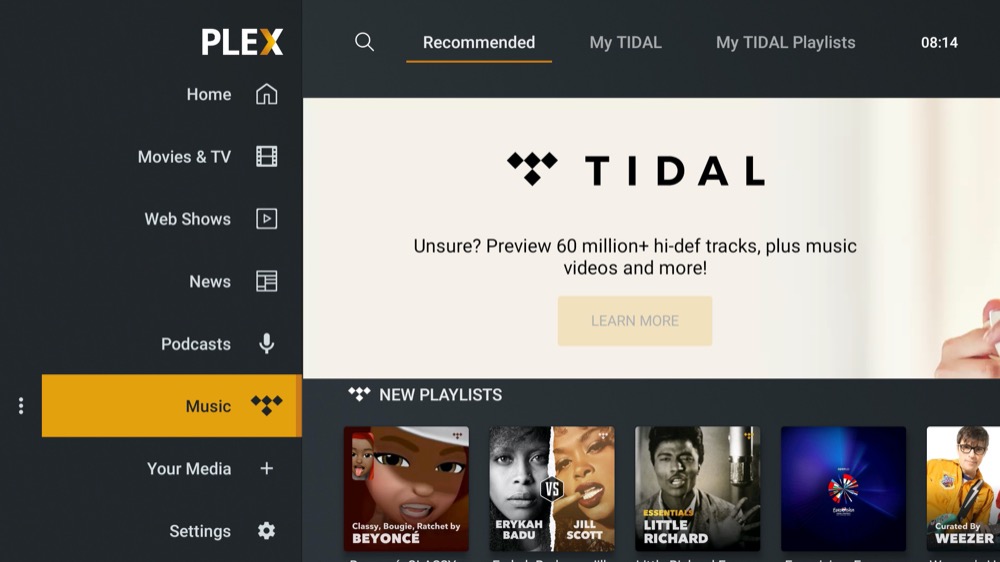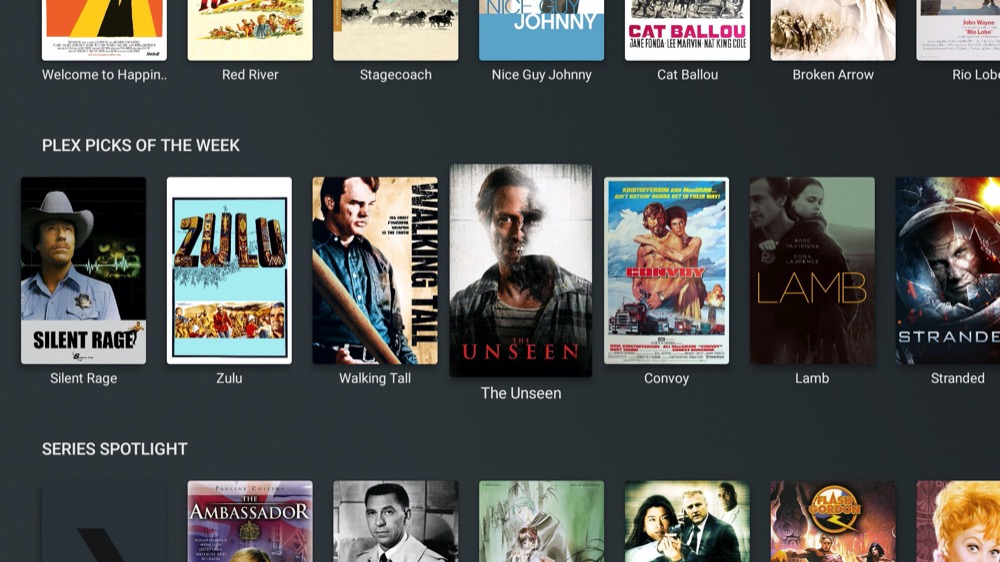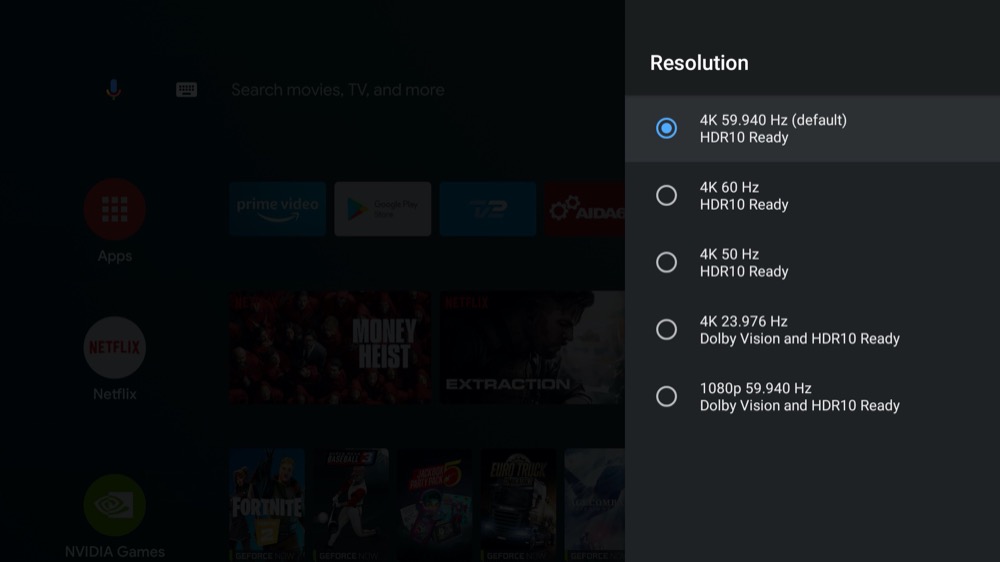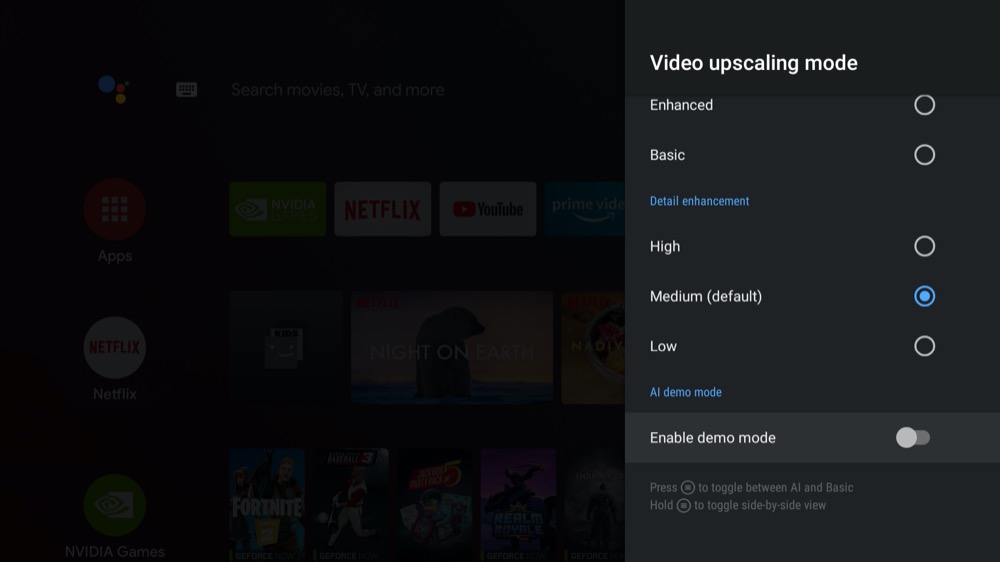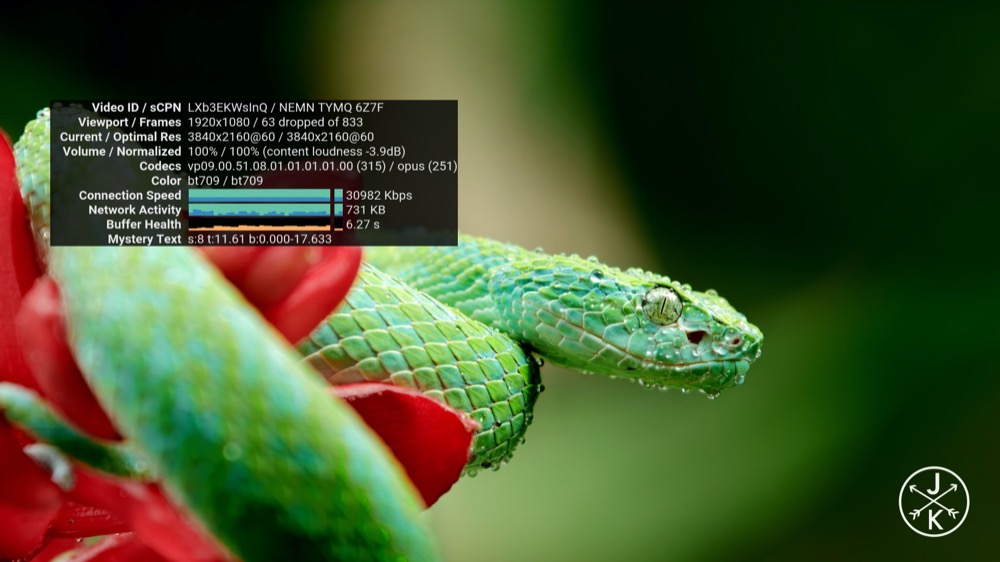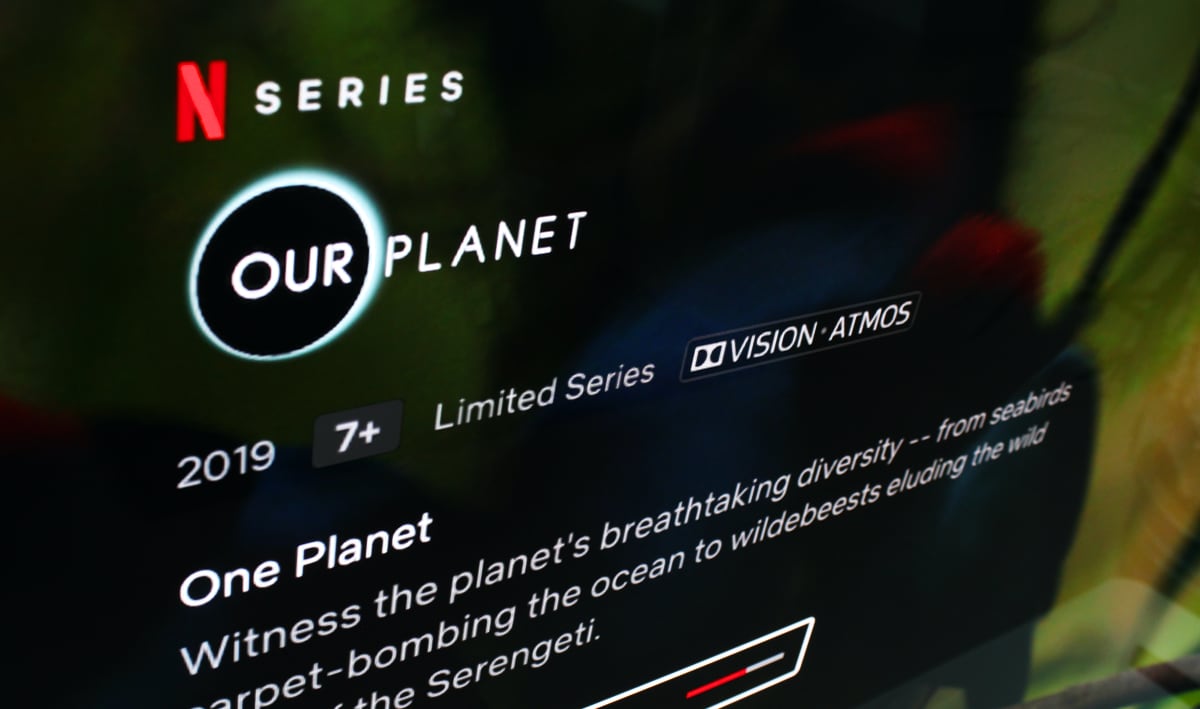Review: Nvidia Shield 2019
In late 2019, Nvidia launched a new generation of the Shield TV box. It had been anticipated for some time as Nvidia had made only small changes to the original hardware from 2015. Shield TV is still considered by many the best Android TV device on the market. Google's operating system is also found in Sony, Philips, TCL, Hisense and Sharp TVs but Shield has more powerful hardware under the hood and comes with built-in gaming services, including GeForce Now. Can Nvidia push the Shield TV forward with the 2019 upgrade? Is this the ultimate fusion of a media player and game console that Nvidia promised in 2015? We have been testing the most affordable tube-version of Shield 2019 for some time. Here is our in-depth review.
First impressions | User experience | Measurements | Picture quality | Media player | Game console | Conclusion Price and retailers:
Nvidia Shield 2019 - specifications
4K Ultra HD resolution
HDR: HDR10 & Dolby Vision(HxWxD) 4 x 4 x 16.5 cm 0.137 kg HDMI (1x 2.0b)
Ethernet (Gigabit)microSD card reader Tegra X1+
8GB (16GB in Pro version)Dolby Atmos, Dolby TrueHD, Dolby Digital Plus
DTS:X (passthrough), DTS-HD (passthrough)WiFi (2.4 & 5GHz – n + ac standard + MIMO)
Bluetooth 5.0 LEMPEG2
MPEG4
HEVC
VP9-1Android TV 9.0 (Pie)
Chromecast built-in
GeForce NowNvidia Remote
Bluetooth game controllersNvidia Remote
Power cableSubscribe to our Newsletter, Facebook, twitter or RSS to receive notice when new reviews are publishedFirst impressions
We reviewed the original Nvidia Shield in 2015. Back then, it came with a more conventional box design. You can still get this design if you pick the 'Pro' version of Nvidia Shield 2019 but the standard version is now a tube-shaped device, which is almost as long as the remote control that it comes bundled with. It is a strange form factor and it does not help that you must connect the power cable at one end and the HDMI cable at the other end. You end up with a thing that is so long that it gets a little unruly, and it takes up more space than you would think. Inside the tube you have 8GB of storage capacity but a good chunk is reserved for the operating system and Nvidia's apps. You can expand storage via a microSD card. There is also an Ethernet port for wired internet, WiFi 5 (ac) and Bluetooth 5.0 LE, which is a step up from the original Shield (2015) and the 2017 refresh. If you want USB ports you must buy the Shield Pro 2019. Nvidia giveth and taketh away. The HDMI connection is HDMI 2.0b - no HDMI 2.1 this time. We will get back to that later. In the box we also found a new remote control and it is worth noting that this is a strategy shift from a company who initially sold Shield as a game console with a game controller. The remote control was optional. Now the game controller is optional. Shield 2019 is now first and foremost a streaming player.User experience & features
Setting up Nvidia Shield has become much easier, mostly as a consequence of Google having streamlined the Android TV set-up process. You can now log in via a mobile app, so you no longer have to use the on-screen keyboard. During the process you have to accept various privacy-intrusive clauses. The set-up process could be streamlined further, however, and it does not match the set-up process of Apple TV where you just place your iPhone on top of the box and use bluetooth triangulation to verify login and get started. This is harder to achieve on Android because Apple does not allow an Android device to pull such data from iPhone and because Android phones come with incongruent hardware specs that complicate compatibility. After setting up Shield we were asked to update the software/firmware, then the remote control firmware, and then pre-installed apps. These steps could have been streamlined. Talking about the user interface and experience of using Nvidia Shield is mainly a discussion about Google's 'Android TV', the version of Android intended for TV devices. Shield is a "stock" Android TV device, meaning that it does not have layers on top such as the tuner sections in Sony, Philips, TCL and Sharp TVs or set-top boxes from distributors of TV channels. Shield has the clean Android TV user interface. As a streaming player manufacturer Nvidia is not allowed to modify the user interface, unlike set-top box makers that are allowed by Google to skin the interface. TV makers like Sony are not allowed to skin the app section of Android TV either but they are allowed to implement their own interface for tuner-based TV channels. In short, Shield's user interface is dictated by the Android TV operation system inside. You will see the exact same user interface in a device like Xiaomi Mi Box. Since the original Shield from 2015 Google has introduced a revamped user interface based on the concept of content rows. Netflix and YouTube can each have their own content row on the home screen in which they can push recommendations or other content. This is a change from the original concept where recommendations were bundled in a single row at the top while other icons on the home screen were simply app shortcuts. We like the new concept but there are obvious limitations as many app developers, especially developers of local apps, have yet to implement the API, meaning that many apps do use the content row feature in any way. The original Nvidia Shield 2015 has also gained this new user interface as part of Nvidia/Google's continuous updates since launch; one reason many consider Nvidia Shield the best Android TV device. Shield started on Android 5 Android 5 (Lollipop) and is now on Android 9 (Pie), which is in line with the history of tvOS updates for Apple TV. However, even a "stock" Android TV device like Shield is subject to long delays. Google will release Android 11 soon but Android 10 (released for TVs in December 2019) has yet to reach Shield. More worrying is the fact that the latest security patch for Shield is from December 2019 - Sony Android TVs have more recent security patches. All-in-all Nvidia does a decent job in terms of updating software, with room for improvement. As for Android 10 it includes official AV1 video decoding support as well as OS-level support for game controllers like Sony's DualShock 4, Microsoft's Xbox controller, and even Nintendo's Switch Pro controller. However, you can already connect lots of controllers, including DS4 and Xbox, to Shield via Nvidia's own drivers. You cannot talk about a TV user experience without talking about the remote control, and in this area Nvidia has really upped its game with Shield 2019. The remote is now triangular and made from cheap, black plastic but it fits well in our hand. It is the functionality side of things that excite us. The remote relies on bluetooth so it is not directional. It may seem trivial in 2020 but many TV remote controls still rely on directional infrared. The big news is that Nvidia has managed to largely match what Apple is doing with the Siri remote for Apple TV, meaning a well-implemented HDMI CEC system that allows you to turn on/off the TV via Nvidia's remote, which is now equipped with an on/off button. From a sub-menu you can also set-up Nvidia's remote to control audio volume on the TV. Ideally, it should have been set-up automatically or be part of the set-up process but nevertheless Shield identified the TV as an LG TV and did the necessary after which we could control audio volume on the TV. The system falls back on infrared, which is also implemented in Nvidia's remote, so for volume control the remote must be pointed towards the TV. The remote has in other words been programmed to use the TV's infrared commands. After these steps everything was smooth sailing and Nvidia Shield can effectively take over as the TV's new operating system, allowing you to put away the TV's convoluted remote control (unless you want to use the tuners in the TV). Furthermore, Nvidia has added a couple of other buttons to its remote, including a sponsored Netflix button, which is becoming more common. It would have been optimal if it had been a user-configurable buttons but luckily there are hack solutions to solve it. There is also a user-configurable button in the top right corner. The remote has backlit buttons that turn on when your viewing environment is dark and you pick up the remote. Nvidia Shield can also be controlled with the official remote app for Android TV. Unfortunately, the app is subpar and frustrating. Besides having to re-pair all the time, it is slow to connect and has delayed text input. The keyboard in the app can be useful when you need to enter login credentials but it often inputs letters twice. The letters in the app's input field do not always correspond to what you are getting on the TV screen either. Google should fix this mess of an app. Perhaps as a result of this, Nvidia has developed its own free app, which provides a better experience. It can also be used to find the physical remote by having it play a sound. It is possible to use other Bluetooth-based remote controls or universal remote controls, including those from Logitech. Like other Android TV devices, Shield supports Google's voice assistant, although most languages remain unavailable on TV devices - evne languages that are supported in Assistant on mobile. If you are using Assistant in English you can ask for weather reports or search for content. "Play House of Cards" was recognized and Assistant opens Netflix. At least when it works... We often encountered errors where it would do nothing at all. Sometimes Google Assistant did not even work on Shield. Other times Assistant sent us to the relevant app but nothing else happened. Voice recognition was also very spotty, with movie titles often being recognized as more commonly used words. Whether this is related to the remote's microphone or Google's Assistant system is unclear but in our view Assistant is of very limited use on Nvidia Shield. Shield 2019 comes with pre-installed apps from Google and Nvidia, but you can customize the home screen by hiding apps. New apps and games can be downloaded from the official Google Play store where only apps designed and optimized for the TV screen are available - no mobile Android apps. If you want to load in a mobile app it can be side-loaded. It is rarely a good idea since many of them are not optimized for remote control input. See the 'Shield as a media player' section for more details. We were not impressed with the performance of the Shield 2015, which despite its powerful hardware was slow, inconsistent and full of errors. The user interface felt unpolished and the user experience as a whole was bad. Subsequent Android updates have made it much, much better and similarly the Shield 2019 provides an overall much smoother and nicer user experience. Google is promising further performance improvements as part of Android 10 and 11.Measurements
In the measurement section we will include all measurements. If you want to learn more about our test methodology click here. Nvidia Shield 2019 has a power consumption of approximately 2W in stand-by, less than half compared to the original version from 2015. Power consumption (average) in active use has also decreased, which is a consequence of the new Tegra X1+ chip that has been manufactured on a 16nm process, meaning that it runs more energy efficient.
Power consumption Watt Standby 1.9 W Menus 3.2 W 4K HDR streaming 6.9 W Gaming 5-11 W
Videofile / source Specs Status Netflix 4K HDR 4K (3840x2160 pixels) – 10 bit colors - Rec.2020 color space – 4:2:0 subsampling – HEVC 4K works
HDR10 works
DV worksYouTube 4K HDR 4K (3840x2160 pixels) – 10 bit colors - Rec.2020 color space – 4:2:0 subsampling – Up to 60fps – VP9 Profile2 4K works
HDR FailsGoogle Play Movies 4K (3840x2160 pixels) – 8 bit colors - Rec.709 color space – 4:2:0 subsampling – VP9 4K works
DV failsJapan AV1 video clip 1080p (1920x1080 pixels) – 8 bit colors - Rec.709 color space – 4:2:0 subsampling – AV1 Fails Cymatic Jazz AV1 video clip 1080p (1920x1080 pixels) – 10 bit colors - Rec.2020 color space – 4:2:0 subsampling – AV1 Fails Shield as a game console
Regardless of whether you are buying the tube or Pro version of the Shield 2019 you get the remote control only. If you want to play games you must buy and connect a bluetooth-based game controller. The good news is that Shield is compatible with many popular controllers, including DualShock 4 and Xbox One controllers. If you have another controller lying around just try to see if you can pair it.Game consoles: Graphical performanceThe original Shield box was sold and promoted as a game console. It is clear that Nvidia's original vision never materialized in earnest. One component of its vision was Android-based games and Nvidia imagined that not only mobile games but also PC games could be ported to Android TV and the (back then) relatively powerful Shield, with its Tegra X1 processor. Shield 2019 is equipped with a Tegra X1+, which according to the company is 25% faster. We have found no evidence to support such claims. The chip is now manufactured on a more advanced node process (16nm versus 20nm). This allows it to deliver similar performance with lower power consumption. It is an optimization but it does little to elevate graphical performance in a TV box that is not restricted by a battery component. The fact that Shield 2019 performs largely in line with the previous chip can be confirmed by benchmarking Shield 2019. In some tests, it exceeds the original chip's performance whereas it struggles to keep up in other tests, depending on what you are benchmarking (1, 2, 3). Tegra X1+ is by the way the same chip as the one found in the latest game consoles from Nintendo; Switch Lite and the latest revision of Switch, although in a throttled version in Nintendo's devices. Tegra X1/X1+ is on paper specified to deliver 512 GFlops of graphical performance, which is roughly on par with the A10X in Apple TV 4K (and the 2017 iPad Pro) but in our benchmark tests, Apple's A10X (in iPad Pro) came out significantly ahead of Nvidia's Tegra X1 (see results). Another factor here is that the tube version of Shield 2019 is equipped with only 2GB of RAM, meaning that several of our benchmark tests could not run at all. It also runs Android in 32-bit mode as opposed to 64-bit in the 2019 Pro version. Android TV is today a 64-inch operating system with 32-bit backwards compatibility (secured by Google requiring all apps to run on 32-bit too). However, there are no guarantees that this will continue in coming years. Apple for example has already ditched support for 32-bit in tvOS and iOS. This limitation of 32-bit in Shield may impact performance later in the lifecycle - not only for games. A few games from the original Shield cannot run on the tube version of Shield 2019 but this is due to them requiring a minimum of 3GB RAM. Titles include Metal Gear Solid 2 og 3, Doom 3, Borderlands 2, Portal, Resident Evil and Tomb Raider from 2013. Add to that the fact that the tube version has only 8GB of storage capacity, with only 4.5GB being available after set-up (a little more can be released by removing pre-installed apps). Hmmmmmm. Has Nvidia given up on its vision to make Shield TV a game console? After 4-5 years, we have roughly the same chip but with downgrades in other hardware areas. You may argue that the Pro version is a better choice but it still comes with only 16GB of storage although it allows you to connect external storage via USB. However, an ecosystem is not defined by the top level or custom configuration options but rather the solutions made available to the masses. We think it is fair to say that Nvidia has at least given up on the idea that Android games can serve as the foundation under a game console. Compared to Apple TV 4K, which recently gained Arcade with its growing library of decent-quality games - but not console-quality games - the game library of Google's Play store is more uninspiring, despite a handful of good titles. One example that is worth highlighting here is Oddmar, which is a great little game that will cost you 5 dollars on Apple TV. On Android TV the game is free but unplayable unless you accept to share your private data, specifically data to "associate you with your personal info on Google", meaning cross-sharing of data to build out your Google profile, which can be used for targeted ads. Games for Android TV are not built on a sustainable model, which is Google's responsibility, and it affects everyone involved including Nvidia. Instead Nvidia has launched its own gaming services on top of Android TV - and only available in Shield. The names and concepts have changed over time - from Nvidia Grid to GeForce Now, from local PC streaming to cloud streaming - so many times that it is hard to keep track but with the official launch of the new GeForce Now game streaming service in February 2020, we finally have a service that could turn out to be successful and help establish Nvidia Shield as a hardware platform for gaming.
Apple TV HDPlayStation 3Xbox 360Apple TV 4KNvidia Shield (2019)Xbox OneXbox One SPS4The official launch of GeForce Now (in its current form) is also one of the reasons why we postponed this review. We tried to get submitted to the beta but without luck. So what is GeForce Now? It is a streaming service for games, much like Google Stadia but with one important difference. It is not "Netflix for games". GeForce Now is instead a technology platform that allows the user to stream games (over the internet) via existing storefronts such as Steam and Epic. Games can be streamed to select devices, including the Shield box, PCs or Android devices. There is a free tier with limitations. A $5 dollar per month subscription plan will give you prioritized access to Nvidia's servers. Game streaming is not a new concept or technology but it is still in its infancy. The main advantage with game streaming is that the game runs on powerful hardware somewhere in a server park, allowing you to use almost any device with a screen to receive the video stream. On the other hand game streaming typically involves some level of latency and the video will also be compressed. It is still not an option for competitive gaming but with continued investment, iteration, and the roll-out of fiber internet it may turn into a solution for the masses sometime in the future. GeForce Now would technically allow Nvidia to scale-down the hardware in Shield even further and still promote high-quality AAA games. A Chromecast Ultra-like device would be enough, which is also what Google is currently using for its competing game streaming service, Google Stadia. Speaking of Stadia, there is still no official word on when the service will be available as an official app for Android TV (and Nvidia Shield). We have played several games on GeForce Now and if you are used to playing on a game console the service may work as an alternative. Picture quality is not as good due to video compression and quality fluctuates (latency too) but when it runs optimally it allows you to fully enjoy lots of great games. The user interface is, however, a mess as you are thrown from one platform to the next (for example Steam), and GeForce Now is probably more suitable for experienced PC gamers rather than the next platform for "two billions players", which is Microsoft's vision for its game streaming platform, tentatively named xCloud, which has yet to launch officially. GeForce Now shows potential and it is a great solution for a TV box connected to the largest screen in the home. Mobile gaming is great - we use it a lot ourselves - but PC games should be enjoyed on the big screen with great picture and sound. But at the same time you are left with the impression that game streaming is not yet mature as a technology, concept or platform. Game streaming, although in more crude form, was also available in the original Shield from 2015 and from other now-defunct services even earlier than 2015. Google is similarly struggling to get Stadia off the ground. There are also technical limitations with GeForce Now as it is currently capped to 1080p60. 4K and HDR are not supported at this time - unlike Google Stadia. The company recommends a broadband connection of minimum 30 Mb/s but ideally 50 Mb/s. Just as important is your local network and we recommend a wired connection to Shield if you want to use GeForce Now.A selection of games:
Tomb Raider
Assassin's Creed Odyssey
Far Cry 5
Fortnite
BioShock Remastered
League of Legends
Trine 4The bad news is the GeForce Now since launch in February 2020 has lots support from multiple major game studios and publishers. First Activision Blizzard (Overwatch, Call of Duty) and Bethesda (Fallout, The Elder Scrolls), and later studios like Xbox Game Studios and Warner Bros IE. This is in addition to EA, Rockstar and Square Enix who were not participating at launch. The situation can be summed up as legal matters. Some game studios say that Nvidia lacks the rights to distribute the games. Nvidia's argument is that it is just a technology facilitator and that the distribution deals with Steam etc. already apply. The battles are fought in this legal grey zone but it casts dark shadow over GeForce Now and due to the current situation we would be cautious to recommend Shield as a game console. Like with the original Nvidia Shield, you can also stream games from a PC over your local network. The system is called Nvidia GameStream and it supports up to 4K60 if your PC is equipped with an Intel Core i7 CPU and GeForce RTX/GTX 1080, or higher. HDR is supported from the GeForce GTX 10 Series and up. A competing system is SteamLink from Valve/Steam that is also available as an app for Android TV.
Shield as a media player
Nvidia Shield runs Android TV, which gives you access to the Google Play catalog of apps and games, optimized for the TV. Mobile apps are not available from Google's TV store but advanced users can side-load them. Just be aware that side-loaded mobile apps rarely work well on the large screen and with remote control input. Also be aware that mobile apps identify themselves as running on a mobile device so streaming services will serve lower-quality streams (resolution and bitrate). Depending on where you live in the world you may have access to a comprehensive or lacking app catalog on Android TV. In our region, the leading streaming service is still missing in action on Android TV and we hear that similar limitations exist in other local markets. You should check if all your preferred apps are available before buying. Unsupported streaming services can often be served via built-in Chromecast instead but then you have to control it from your smartphones. On the other hand Android TV has a rich selection of advanced media player apps, including Kodi, Plex, and VLC. Kodi has become one of the most popular solutions because it supports advanced features as well as plugins - unlike Kodi forks on Apple TV. This gives you flexibility to expand it in various ways.If you prefer to use online streaming you will find most major services including Amazon, Netflix, Disney+, HBO, and YouTube. Some apps will look identical to their counterparts on other TV platforms whereas others will be scaled-down versions that feel more like a 'home page' than a native app, which is often what they are. One implication is that the app user experience can at times feel subpar and inconsistent on Android TV. Some apps are excellent while others feel slow and laggy, despite the relatively powerful hardware in Shield. Some apps slide elegantly to the background whereas other apps insist on asking you if you really, really want to close it (for example Amazon). As the platform owner, we hope that Google will start to exercise a little more control to provide users with a more consistent and pleasant user experience on Android TV. At least in terms of major streaming services (let Kodi be Kodi). A bigger source of irritation, however, is that Shield 2019 is incapable of keeping apps in memory, most likely due to its limited RAM. There are a few situations where you can be lucky to have for example the Netflix app resume when you jump back in but most of the time it has to load from scratch again, with its splash screen and profile picker. This is hugely disruptive to the user experience and it also creates 'distance' between the app interface and the home screen where content is highlighted and featured. For this concept to work seamlessly you should be able to jump into an app almost instantly and start enjoying the content. It feels wrong to call Shield underpowered but in terms of RAM it is - like the majority of other Android TV devices - and such hardware limitations affect the Android TV ecosystem. With the launch of Shield 2019, Nvidia has implemented two new video features in the form of Dolby Vision support and 'match frame rate' (in beta). Although not related per se, there are some situations were they get intertwined so let us start by zooming way out. Once upon a time, content ecosystems were sharply defined. TV channels were broadcast in specific formats (30/60Hz in the US, 25/50Hz in Europe) so all content was converted to fit before being broadcast. Movies were - or are - designed for cinema, which means 24fps, so a Blu-ray player's job was to present movies in this way. It meant that you could design a set-top box or a Blu-ray player based on the ecosystem paradigm. Streaming technology provides us with new means for distribution, and more flexibility. With streaming distribution, the provider does not have to settle beforehand on a single distribution format - like with TV channels. The provider can simply put yet another version of a movie online on the server, to be served to compatible devices. Netflix, for example, has all of its titles stored in SD, HD and sometimes 4K resolution, with or without HDR10 and with or without Dolby Vision, and in multiple bitrates for each combination. Of course, providers can still convert content - and some do - but there is no good reasons to do it any longer (most conversions will degrade video quality or introduce judder). It follows that a Smart TV or a streaming player should be flexible and built on a foundation that makes all of this possible. Streaming players should open doors, not close doors. Unfortunately, most Smart TVs and streaming players are not built on such a foundation. It is not easy either as there are still technical limitations (in HDMI etc). If you add SDR/HDR to the mix, the situation becomes even more complex so streaming players have be even more flexible. The solution to the challenge is so-called match functions where the player matches its video pipeline and output to the content's frame rate (24, 25, 50, 60 etc) and dynamic range (SDR / HDR). The goal is to let video pass without converting it in any way. A match function can be manual or automatic. It can work on the app or system level. The optimal situation is an automatic solution implemented on the system level, which means that it will work automatically in apps running on the operating system. Since 2017, Apple TV 4K has - as the only TV platform - offered automatic, system-level match functions for both frame rate and dynamic range. It works with all apps that use the standard video player in tvOS but apps taking advantage of a custom video player must implement the API. However, Apple's match functions are off by default so the user must activate them first. This decision was most likely made because frame rate switching from an HDMI source involves a brief black screen every time it changes the frame frequency. This is a limitation in the HDMI standard (until HDMI 2.1's QMS). Google's Android TV platform supports frame rate switching but the important distinction here is that it is not supported on the system level and that it is not automatic. Instead, it is offered as an API - a tool for developers - that can be implemented in apps. Unfortunately, the vast majority of streaming providers are ignoring the API at this time. Nvidia has developed its own solution. It is a step in the right direction but unfortunately not a complete solution. The match function is manual, not automatic, so you have to manually click 'match' every time you start a new video stream. And even though the feature can be mapped to the top button on the remote control, limitations apply. Some apps crash when you try to use the match function and probably for the same reason Nvidia characterizes it as 'beta'. When it works, it works well (and also supports 24.000), but a manual function is not a solution to the challenge and it will not help 99% of users. If you opt not to use the match features you will encounter judder due to frame rate conversion in the box, depending on what you have set default output to. If you select 4K 60Hz output, European content (25/50Hz) will have judder. If you select 4K 50Hz output, American content, including movies and TV series (24fps), will have judder. This is where Dolby Vision and the match functions collide. Dolby Vision support is a nice addition to Nvidia Shield but useless on a handful of Dolby Vision-compatible TVs, including our LG E6 OLED TV that was used for this test. The reason is that some TVs support Dolby Vision in up to maximum 30Hz. To get Dolby Vision on Nvidia Shield to function with these TVs you must set Nvidia Shield's default output to for example '4K 23.976Hz Dolby Vision and HDR10 Ready' or alternatively lower the resolution for the entire system (meaning also streaming services), for example to 1080p HD resolution. Both solutions will give you Dolby Vision but in the first example Android TV menus and all app user interfaces will be rendered in 24fps, which is unendurable, while the other example is a very big picture quality compromise. With TVs that support Dolby Vision in up to 60Hz it works as intended. We could discuss other nuances of Nvidia's match functions but the point is that as long as it does not work automatically on the system level, and as long as there are technical limitations, it is not viable solution. Unfortunately. A few apps, including Kodi, have their own match functions implemented so if you stick to using that app only you are good, but it does nothing to rectify the situation for the rest of the streaming services on the platform. Our recommendation is therefore that you set Nvidia Shield to 4K 50Hz output if you watch primarily European content or 4K 60Hz if you watch primarily American content, movies and TV series. And then try to remember to use the manual match function whenever it makes sense. Another new feature in Nvidia Shield 2019 is 'AI Upscaling', which works with content in up to 1080p HD and 30fps. For a decade or more, upscaling has been marketed as almost a magical ability in TVs and it would seem that many users still lack basic knowledge about why upscaling is necessary. It is really very simple. Without upscaling you would not get a full-screen picture. All TVs employ upscaling. Otherwise 1080p video would take up only a fourth of the screen in a 4K TV - 720p only a sixth. Like so many other things these days that are named "AI" - artificial intelligence - the system in Nvidia's box has been developed with machine learning (that has generated an image database). In practice, such "AI" system often just modify their upscaling approach slightly depending on the frame rate or type of content. And the processes that do this are in fact not upscaling processes but rather picture enhancement processes. It is important to distinguish between the two concepts if we want to have a meaningful discussion about upscaling. As the industry found out more than a decade ago, it helps to just put everything into a pot, cook it, and sell it as "upscaling". This approach to "AI" upscaling is not even new either. It has been employed in TVs since the launch of the very first 4K TVs from Sony in 2012. Only later did manufacturers start to refer to it as "AI". So how does it work? Exactly as expected. It changes the characteristics of the picture and makes it appear more 'digital'. The main approach is to add contrast lines around sharply defined objects, for example a human face or a flower, or to add pixel noise in-between color/contrast transitions. From a distance this will, for some time, give the impression of a sharper picture. It is one of the tricks that are commonly used on TVs in "shop mode" as an eye-catcher. It may look impressive at first (just like heavily oversaturated colors) but once you realize how it works, it is hard to ignore the negative effects, e.g. that it changes the picture and makes it look more artificial and digitalized. With heavily compressed video it makes the picture look even more compressed - not less. In some scenes it even changes the color tone of an object, which has absolutely nothing to do with upscaling. In other scenes Nvidia's system (also observed with some other systems in TVs) wrongly try to make blurred backgrounds or objects come into focus, which alters the perspective or depth of the scene. If similar upscaling is engaged in the TV, you get a double effect. There is demo mode in Shield that you can enable to check how it looks with any compatible content. Notice how it alters edges, objects, and color/contrast transitions in the picture. We fundamentally believe that any player or TV should, in its default mode, refrain from applying picture enhancements. You can call it the mindset of a purist but the truth is that if content creators really wanted such effects to be applied, they would just do it in the studio or later in the chain; when the content is edited, when it is compressed/prepared etc. Studios could also apply it much more effectively earlier in the chain. In a TV or a device like Shield it has to happen in real time. Even the smallest amount of picture analysis adds video latency, which can lead to issues with picture / audio syncronization. It would not work well with gaming either. Even if you do not accept this premise you should know that the concept is neither new or unique. Many modern TVs can do the same and you should deactivate it, if you want enjoy the content as the creator intended. Picture enhancements are like sugar; it feels good to eat and you are tempted to eat more. You are not able to look at it from a perspective and see that it may not benefit you until after you stop. Which brings us to true picture quality metrics. At this time, Android TV / Shield supports 4K and/or HDR10/Dolby Vision from streaming services like Amazon Video, Netflix, Google Play Movies, Disney+ and YouTube. Google Play Movies has been offering movies in 4K and HDR10 for some time and recently started rolling out Dolby Vision. Nvidia Shield does not support it at this time but we hope to see support roll out later. Also read: First Dolby Vision titles appear in Google Play Movies YouTube on Nvidia Shield 2019 can be enjoyed in 4K resolution but is still limited to SDR. HDR is not supported. The reason is that Shield lacks support for both VP9-2 (it has VP9-1) and AV1 decoding in hardware. It is a strange situation when the standard bearer for Google's Android TV platform, Nvidia, lacks support for a several years old format (VP9-2) developed by Google. The industry, including Apple, Google, Netflix, Microsoft and Nvidia, are now collaborating to promote the royalty-free AV1 video format. It is still a relatively new format and codec but Netflix and YouTube have started transitioning to it. Considering that both Google and Nvidia are members of the alliance, it is a strange omission in Shield 2019. We had hoped that AV1 support was hidden in the box. Officially, AV1 will not be supported until Android 10 but of course Nvidia could have enabled it in other ways. Initially, we found that Nvidia Shield 2019 was capable of decoding an AV1 video clip in 1080p (24fps SDR) through the VLC app, but it appears to be a solution where AV1 is decoding in software. The clip would not play in other apps (Kodi including). Any AV1 video in higher resolution or frame rate would produce tons of playback errors or simply not play. To exclude other error factors, we sourced the same video clip in AV1 and VP9, all other video parameters unchanged. The VP9 clip worked on Shield 2019, while the AV1 clip failed. YouTube did not pull down AV1 video either even though the same video would play in AV1 through Chrome on a PC or a compatible Smart TV. There is nothing to suggest that AV1 support is hidden in Shield 2019. As for audio support, Nvidia Shield excels in this area where other streaming players such as Apple TV 4K lack some capabilities that enthusiasts value. Specifically the option to bitstream Dolby Atmos and DTS:X in lossless audio codecs Dolby TrueHD and DTS-HD MA. At this time, all streaming services serve Dolby Atmos in Dolby Digital Plus (E-AC-3) and Dolby has more than suggested that the next step for streaming will be AC-4 (codec for audio compression). Dolby TrueHD is the lossless codec used for Atmos on Blu-ray and UHD Blu-ray discs. Of course, Nvidia Shield is not a disc player but if you have ripped versions of your Blu-ray movies Shield can play them with apps like Kodi. Support for higher audio quality may be an important factor for users with a large library of ripped movies. If you use streaming services there are no benefits to be had at this time. Although the previous versions of Nvidia Shield are capable of handling certain aspects of Dolby Atmos, they lack official support for Atmos (a license from Dolby). Shield 2019 is the first to offer Atmos decoding, meaning that you can pull down Atmos from streaming services like Netflix. On the other hand Nvidia Shield (and Android TV) lacks flexibility in audio. There are signs that Android TV devices can soon be used as playback destinations in Google's multi-room system but at this time the feature is not active in our Shield. It is not possible to wirelessly connect Chromecast-compatible speakers to Nvidia Shield (or any Android TV device) either. Such functionality is currently exclusive to Apple TV (with AirPlay speakers) and Roku TVs (with Roku speakers). Another new development is HDMI 2.1 along with its optional features like ALLM (Auto Low Latency Mode), QMS (Quick Media Switching) and VRR (Variable Refresh Rate). None of these are supported in Nvidia Shield 2019, which is a shame considered that TV makers are now starting to transition to HDMI 2.1. The timing of the launch of Shield 2019 seems to suggest that Nvidia is not yet ready to transition to the 'next generation', i.e. AV1 and HDMI 2.1. If the company was on the verge of releasing a new Tegra chip with AV1 and a new hardware platform with HDMI 2.1, we doubt that it would have launched the 2019 box.Kodi
Kodi (formerly XBMC) has become one of the community favorites as a full media player solution for TV that supports many advanced video formats and features. It can be modified to your liking with 'skins' and on Shield you can also expand Kodi functionality through plugins of various kinds. Kodi on Shield supports automatic frame rate switching, including to 24fps. The user interface is not as user friendly and polished as some other media player apps but that is fine as Kodi aims to serve more advanced users who like to tweak things. Kodi is the app on Shield if you have a large library of ripped movies stored in local or network-enabled storage.Plex
Plex is available on most platforms and used to be more comparable in style to Kodi, although with a more streamlined look and fewer customization options. To use Plex you would set-up a local file server on your PC/Mac or some network-attached storage. The server would handle video transcoding. Plex has later expanded to include many other features, including cloud services and storage, online music streaming, and a library of movies that can be enjoyed for free with (too many) ads. Plex today is very different from Plex 5-10 years ago but it is still an excellent media player that many continue to use with great satisfaction.Conclusion
Nvidia Shield 2019 is story about improvements in software more so than improvements in hardware. Since the original Shield in 2015, Google's Android TV platform has been redesigned around the concept of content rows. The user interface is more inviting and everything more polished so Shield no longer caters only to enthusiasts (with Kodi, Plex etc) but also a wider subset of users who primarily use streaming services. Some streaming apps are still missing though.Ad:It is surprising how little improvement there is in Shield's 2019 hardware compared to the 2015 box. The new tube-design for Shield (with 8GB of storage) is not a succes in our opinion whereas the new remote control represents - besides its cheap plastic enclosure - a major step forward. The remote now configures itself to control your TV (on/off, volume after manual set-up). At the same time Nvidia has realigned its focus to center on streaming. Shield now comes bundled with the remote control rather than the game controller, which is optional. That is a reversal from the market positioning of the original Shield. The Tegra X1+ is fundamentally the same chip as the 2015 version, and there is no support for VP9-2, AV1 or HDMI 2.1 in the new box. Nvidia has also opted to reduce storage capability so Shield now starts at 8GB (4.5GB free after OS, apps), which is sad. 8GB is far from enough and we were constantly forced to remove apps and games. As a platform for gaming, Android TV has so far failed to live up to its potential as a bridge to bring mobile games to the TV screen. Nvidia is now focusing on GeForce Now, its own streaming services for games. It is unique to Shield as it has not been made available for other Android TV devices. The quality of apps is generally lower than on some competing TV platforms and one big source of frustration is that Shield 2019 is constantly dropping apps from memory, meaning that an app has to load again almost every time you open it - even if it was open a minute ago. Nvidia's manual match frame rate function (in beta) is not up to par with Apple TV 4K's automatic, system level match functions, and it makes Dolby Vision in Shield 2019 useless with some TVs. Official Dolby Atmos support (decoding) is a nice addition. Nvidia Shield 2019 offers a much improved user experience compared to the original version but these improvements are mainly a result of continuous software releases for Android TV - updates that are also available for the original box. You are left with an impression of lack of progress in the 4-5 years that have passed, and the timing of the launch suggests to us that Nvidia will not be a first-mover in the areas of HDMI 2.1 and AV1, both of which are starting to emerge in some market segments. Nevertheless, Shield 2019 is a good media player and the best Android TV device on the market, albeit pricey.Price and retailers:
Apps is an evaluation of the app catalogue and the quality / user friendliness of the apps
Features is an evaluation of the built-in functionality and how useful it is, as well as build quality
User experience is an evaluation of user friendliness and the general use of the box, including the remote control
Total score weighted as: 40% Apps, 30% Features, 30% User experience.
All scores are calculated based on a moving maximum target, defined by what we currently consider the best on market. It is then presented as a percentage. This means that a score will fall over time as new and better media boxes set new standards. This allows you to compare scores across years. A score of 100% in a given category means that it is consider the best available media box in this category to dateClick for a more detailed explanation of the score system and our Awards
Best Android TV device
4K Dolby Vision & Atmos
GeForce Now service
Android TV receives updates
Redesigned remote controlAlmost same hardware, only 8GB storage
No HDMI 2.1, AV1
Incomplete match functions
YouTube not in HDR
Price

